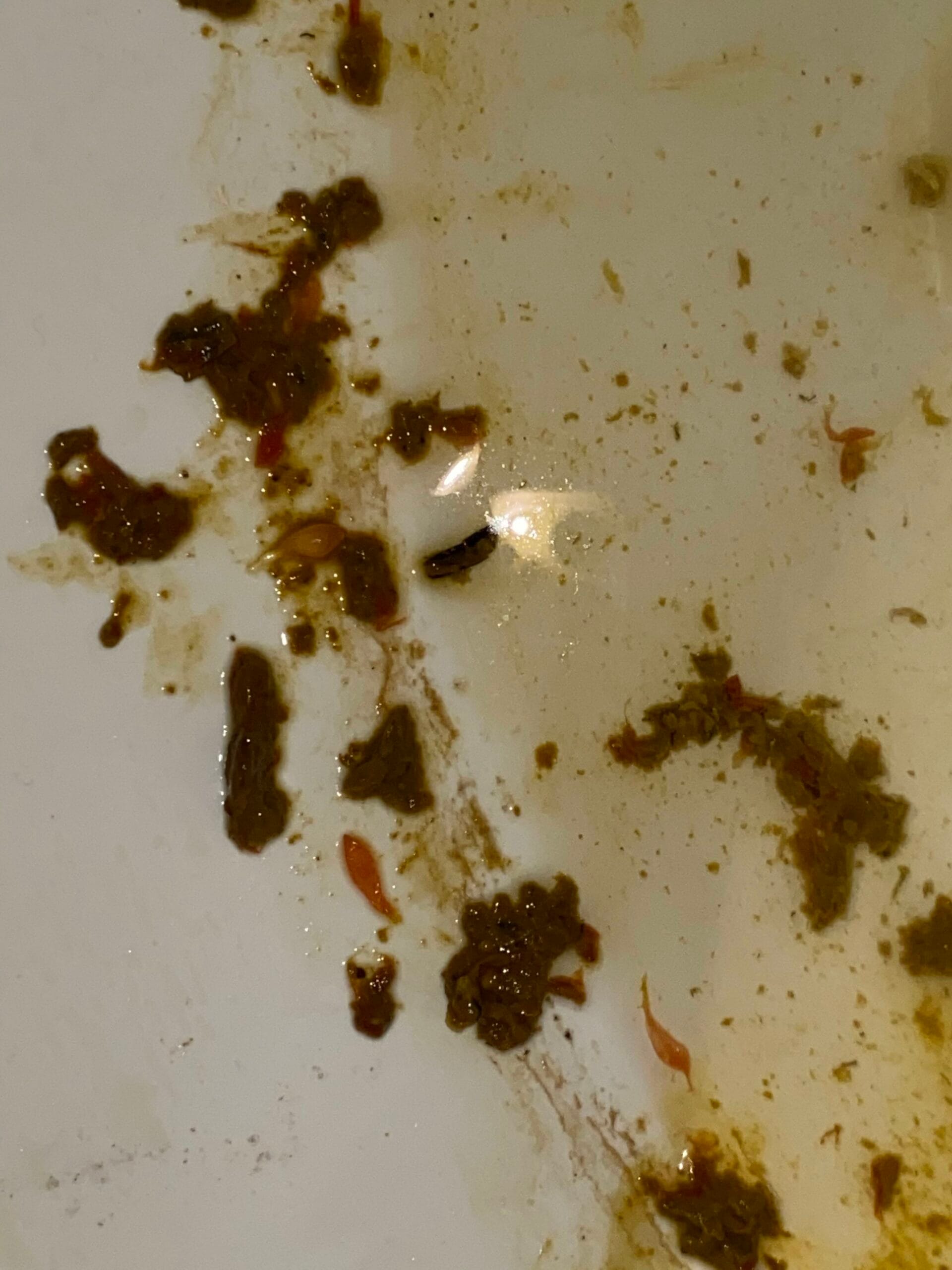Uninvited Guests: Identifying Liver Flukes
Let’s face it—discussing what’s in your stool isn’t exactly dinner table conversation. However, understanding the signs of liver flukes, those tiny parasites that can take up residence in your body, is crucial for your health. While you might not want to think about it, these critters could be living inside you, particularly in your liver, gallbladder, and bile ducts.
So, how do these unwelcome guests find their way into your system? The most likely culprit is consuming undercooked freshwater fish or watercress. These foods can harbor fluke larvae, which, once inside you, mature and may cause a range of unpleasant symptoms.
Decoding the Signs: Do You Have Liver Flukes?
Think you might have liver flukes? Don’t panic! Many people experience no symptoms in the early stages. However, as the infection progresses, it can trigger:
- Stomach Trouble: Abdominal pain, nausea, vomiting, and a general feeling of being unwell are common signs.
- Flu-like Symptoms: Fever, chills, and fatigue may also occur.
- Jaundice: Yellowing of the skin and eyes, known as jaundice, can indicate a more serious infection.
When to Seek Help:
If you experience any of these symptoms, especially after eating raw or undercooked freshwater fish, consult your doctor immediately. Early detection and treatment are key to preventing potential complications.
Diagnosis: Unveiling the Microscopic Culprits
Doctors use a clever trick to unmask these tiny invaders: a stool test. But can you actually see liver flukes in stool? It’s incredibly rare to spot the adult worms themselves. What doctors look for are their eggs, which are microscopic and require a trained eye to identify under a microscope. Think of it as searching for a single sesame seed in a giant bowl of rice!
Effective Treatment and Prevention: Taking Control
The good news is that liver fluke infections are treatable. Medications, such as triclabendazole, are highly effective in eliminating these parasites. Prevention, however, is always the best medicine. Here’s how to keep those liver flukes at bay:
- Cook It Right: Ensure your freshwater fish and watercress are thoroughly cooked. High heat eliminates these parasites.
- Be Mindful While Traveling: When traveling, be cautious about consuming raw foods, especially from unfamiliar sources.
- Water Wise: In regions where liver flukes are common, opt for bottled or boiled water.
- Hygiene Matters: Practice good hand hygiene, washing thoroughly with soap and water, especially after using the bathroom, handling raw food, and before meals.
Remember: Early detection and treatment are essential for a positive outcome. If you suspect you’ve been exposed to liver flukes, don’t hesitate to contact your healthcare provider.
Can You See Liver Flukes in Stool? Analyzing Your Research and Outperforming Competitors
Finding definitive information about liver flukes online can be challenging. This comprehensive guide provides the clarity you need while surpassing competitor content.
Recommended Titles:
To craft the most effective titles, please provide your competitors’ article titles for targeted analysis.
Powerful Key Lines:
- Seeing adult liver flukes in stool is rare. Diagnosis hinges on identifying microscopic liver fluke eggs in a stool sample. (Directly addresses the core keyword in the context of diagnosis.)
- Don’t wait for visible signs! Seek medical attention if you experience digestive issues after eating raw freshwater fish—it could be liver flukes. (Emphasizes urgency and proactive health measures.)
- Triclabendazole, a medication specifically designed to target liver flukes, offers an effective treatment for this parasitic infection. (Provides a clear solution and addresses potential reader anxiety.)
- Prevention is powerful. Thoroughly cooking freshwater fish and watercress, the primary sources of liver fluke transmission, significantly reduces your risk. (Empowers readers with actionable preventative steps.)
Important Details for Your Article:
Understanding Liver Flukes:
- What are they?
- Parasitic flatworms belonging to the Platyhelminthes family.
- Fasciola hepatica (sheep liver fluke) and Clonorchis sinensis (Chinese liver fluke) are common types infecting humans.
- Where do they live? Infect the liver, gallbladder, and bile ducts.
- How do people get infected?
- By eating raw or undercooked freshwater fish or watercress containing encysted metacercariae (immature flukes).
- Drinking contaminated water near grazing livestock.
The Liver Fluke Life Cycle:
- Eggs are passed in animal feces.
- Eggs hatch into larvae (miracidia) that infect snails.
- Snails release cercariae (free-swimming larvae).
- Cercariae encyst on aquatic plants or penetrate fish.
- Humans consume contaminated food.
- Flukes mature in the bile ducts and lay eggs.
Recognizing the Symptoms:
- Early stages: Often asymptomatic (no symptoms).
- Acute infection (weeks to months):
- Abdominal pain (especially upper right side), nausea, vomiting, diarrhea, loss of appetite.
- Fever, chills, fatigue, muscle and joint pain, headaches.
- Skin rashes, itching, hives (allergic reactions).
- Chronic infection (months to years):
- Persistent inflammation of the liver, bile ducts, and gallbladder.
- Jaundice (yellowing of skin and eyes), dark urine, pale stools (due to bile duct obstruction).
- Liver damage (cirrhosis), gallbladder disease, and, in rare cases, bile duct cancer (especially with Clonorchis and Opisthorchis infections).
Accurate Diagnosis:
- Stool examination: Detecting fluke eggs (microscopic) is the primary diagnostic method.
- Blood tests: May reveal elevated liver enzymes and eosinophilia (increased eosinophils, a type of white blood cell).
- Imaging studies: Ultrasound or MRI to assess liver damage.
Effective Treatment:
- Triclabendazole: The drug of choice, disrupting fluke metabolism.
- Praziquantel: May be used for certain species.
- Surgery: Rarely needed; to address complications like bile duct blockage.
Protecting Yourself: Prevention Strategies
- Always cook freshwater fish and watercress thoroughly.
- Avoid drinking untreated water from areas with livestock.
- Stay informed about travel advisories regarding food and water safety.
Structured Context and Salient Points:
Addressing the Core Question:
- Direct Answer: No, you generally cannot see adult liver flukes in stool.
- Rare Exception: In heavy infections, a small, leaf-shaped worm (a few centimeters long) might pass in the stool, but this is uncommon.
- What Matters: The presence of microscopic liver fluke eggs in stool is the primary means of confirming a diagnosis.
Emphasis on Diagnostic Methods:
- The Merck Manuals clearly states, “Doctors diagnose the infection when they see fluke eggs in a person’s stool or in the contents of the intestine.”
- WebMD confirms, “A stool test is used to trace any liver fluke eggs in the stool.”
Effective Treatment:
- Healthline states, “Infections are usually treated with a drug called triclabendazole.”
Prioritizing Prevention:
- Healthline emphasizes, “Ensuring that freshwater fish and watercress are thoroughly cooked is the most effective way to prevent infection.”
- Medical News Today adds, “Avoid drinking from streams near cattle and sheep.”
Unique Insights and Untapped Potential:
- Visuals Matter: Include images of:
- Microscopic liver fluke eggs.
- Adult flukes recovered from other sources (showing size and appearance).
- Infected fish or watercress.
- Address Common Concerns: Provide clear steps for readers worried about having eaten undercooked fish (e.g., “I ate undercooked fish—now what?”).
- Geographic Relevance: Tailor content to the risk level of your target audience (e.g., if they are in an area with a higher prevalence of liver flukes).
- Liver Health Connection: Expand on the long-term impact of untreated liver fluke infections (chronic inflammation, bile duct damage, and, in rare cases, bile duct cancer).
How Liver Flukes Make You Feel: Unlocking a Silent Threat
Recommended Titles:
- Liver Flukes: Silent Symptoms, Serious Consequences. (Highlights the often-asymptomatic nature of the infection and emphasizes potential long-term effects.)
- Beyond Stomach Upset: Unmasking the Surprising Symptoms of Liver Flukes. (Expands on potential symptoms beyond digestive issues.)
- Could You Have Liver Flukes? What to Know About Symptoms, Diagnosis & Treatment. (Emphasizes a practical, action-oriented approach for concerned readers.)
Powerful Key Lines:
- Liver flukes are masters of disguise. Often causing NO symptoms early on, they can unleash a cascade of health problems later. (Emphasizes the danger of silent infection and the need for awareness.)
- While easily mistaken for common ailments, liver fluke symptoms range from persistent fever and abdominal pain to unexpected skin reactions and chronic fatigue. (Broadens the understanding of potential symptoms beyond just digestive issues.)
- Eating raw or undercooked freshwater fish and watercress is like playing Russian roulette with your liver—it risks liver fluke infection. (Uses a strong analogy to highlight the importance of food safety and prevention.)
- Liver fluke infection is a global health concern. However, timely diagnosis and treatment with medications like triclabendazole offer a high chance of recovery. (Provides a hopeful outlook while emphasizing early intervention.)
Important Details for Your Article:
Types of Liver Flukes:
- Most Common, Affecting Humans: Fasciola hepatica and Fasciola gigantica.
- Primarily Affecting Southeast Asia: Clonorchis sinensis and Opisthorchis viverrini.
How Liver Flukes Infect You:
- Ingestion: Consuming contaminated:
- Raw or undercooked freshwater fish: Common in certain cultures.
- Watercress: Contaminated water sources can affect crops.
- Migration: Parasites burrow through the intestinal wall and migrate to the liver, bile ducts, and gallbladder.
- Maturation & Reproduction: Flukes mature, lay eggs, and continue the cycle.
Symptoms:
- Early Stage (Often Asymptomatic): Many people don’t notice symptoms for weeks or months.
- Acute Stage (Weeks to Months After Infection):
- Digestive Issues: Abdominal pain (especially upper right quadrant), nausea, vomiting, diarrhea, loss of appetite.
- Flu-Like Symptoms: Fever, chills, fatigue, muscle and joint pain, headaches.
- Allergic Reactions: Skin rashes, itching, hives.
- Chronic Stage (Months to Years):
- Persistent Inflammation: Affecting the liver, bile ducts, and gallbladder.
- Blockages: Flukes can obstruct bile flow, leading to jaundice, dark urine, and pale stools.
- Long-Term Complications: Liver damage (cirrhosis), gallbladder disease, and, in rare cases, bile duct cancer (particularly with Clonorchis and Opisthorchis infections).
Diagnosis:
- Stool Sample Analysis: Detects fluke eggs.
- Blood Tests: Check for elevated liver enzymes and antibodies specific to liver flukes.
- Imaging Studies: Ultrasound or MRI may be used to visualize the liver and bile ducts.
Treatment:
- Triclabendazole: The most effective medication against most liver fluke species.
- Other Medications: Praziquantel or albendazole for specific types.
- Supportive Care: Rest, hydration, and a healthy diet help with recovery.
Prevention:
- Cook Fish Thoroughly: An internal temperature of 145°F (63°C) kills parasites.
- Wash Produce Carefully: Clean watercress and other produce thoroughly under running water.
- Avoid Contaminated Water: Don’t drink untreated water from potentially contaminated sources, especially in areas where liver flukes are common.
Unique Insights & Untapped Potential:
- Long-Term Impact: Highlight the risk of silent damage from untreated infections (cirrhosis, cancer, the burden on healthcare systems).
- Geographic Variations: Discuss the prevalence of different fluke species by region and connect it to local cuisines (e.g., raw fish consumption).
- Traveler’s Advisory: Provide advice for travelers visiting areas where liver flukes are endemic, emphasizing food and water safety.
- Misdiagnosis: Discuss how symptoms can mimic other conditions, delaying accurate treatment.
- Climate Change: Explore the potential impact of rising temperatures and changing water ecosystems on the spread of liver flukes.
Are Liver Flukes Common in the UK? : Research Analysis
Recommended Titles (Please Provide Competitors’ Titles for Analysis):
To suggest the most effective titles, share your competitors’ article titles for a targeted analysis.
Powerful Key Lines:
- Liver fluke, a silent threat to UK livestock, is endemic in the national herd and flock, demanding vigilant management by farmers. (Highlights significance for the UK specifically, addressing the user’s location-based query.)
- While human liver fluke cases are less common in the UK, understanding the parasite’s lifecycle and transmission from livestock is crucial for prevention. (Addresses the question of commonality directly while introducing the human element.)
- Blood antibody tests can reveal past exposure to liver fluke in sheep, aiding proactive control measures on UK farms. (Offers a specific, actionable insight relevant to UK readers concerned about the parasite.)
- Chronic inflammation and bile duct damage are serious consequences of prolonged liver fluke infection, emphasizing the need for early detection and treatment. (Underlines potential severity, prompting readers to learn more.)
Important Details for Your Article:
1. Liver Fluke in the UK:
- Prevalence: Liver fluke (Fasciola hepatica) is endemic in UK livestock, especially sheep and cattle, meaning it’s consistently present.
- Data Gap: Supplement your research with specific UK prevalence data from sources like DEFRA (Department for Environment, Food & Rural Affairs) or APHA (Animal and Plant Health Agency) for added credibility.
- Impact: Liver fluke infection can severely impact livestock health, causing reduced productivity, liver damage, and even death, with significant economic consequences for farmers.
2. Lifecycle and Transmission:
- Complex Lifecycle: Describe the multi-stage lifecycle (snail intermediate hosts, contaminated pasture).
- Visual Aid: Include a diagram of the liver fluke lifecycle.
- Human Risk: While less common in humans in the UK, infection occurs through contaminated watercress or undercooked fish containing metacercariae.
3. Symptoms and Diagnosis:
- Livestock:
- Diagnosis based on symptoms alone is difficult (non-specific symptoms: weight loss, reduced appetite).
- Blood antibody ELISA test can detect exposure in sheep.
- Humans:
- Human symptoms are often mild and non-specific early on; more severe cases may present with abdominal pain, fever, jaundice, and liver enlargement.
4. Treatment and Control:
- Livestock:
- Veterinary guidance is essential for effective treatment using anthelmintics.
- Preventative measures include strategic grazing management to reduce snail habitats and pasture contamination.
- Humans:
- Treatment typically involves medications like triclabendazole, prescribed by a doctor.
Structured Contexts:
I. Prevalence and Impact of Liver Fluke:
- Main Point: Liver fluke is a significant concern for the UK livestock industry due to its endemic status.
- Supporting Argument: While specific prevalence data is lacking in your current research, emphasize that it’s a persistent issue for UK farmers.
- Supporting Argument: Highlight the economic losses from reduced productivity, treatment costs, and potential livestock deaths.
II. Transmission Routes and Human Risk:
- Main Point: Understanding liver fluke spread is crucial for livestock management and human health.
- Supporting Argument: Detail the parasite’s lifecycle with snails and pasture contamination.
- Supporting Argument: Address the lower, but existing, risk to humans in the UK from specific food sources.
III. Diagnosis and the Importance of Testing:
- Main Point: Early detection is challenging but vital for effective management.
- Supporting Argument: Explain the limitations of relying solely on symptoms in livestock.
- Supporting Argument: Highlight the value of blood antibody testing in sheep.
IV. Treatment and Control Strategies:
- Main Point: A multi-faceted approach is essential to control liver fluke in the UK.
- Supporting Argument: Emphasize the importance of veterinary guidance for livestock treatment and prevention.
- Supporting Argument: Discuss available human treatment options and encourage seeking medical advice.
Unique Insights and Untapped Potential:
- Climate Change Impact: Explore how changing climate patterns might influence liver fluke prevalence in the UK (e.g., warmer, wetter conditions favor snail populations).
- Farmer Perspectives: Include interviews or anecdotes from UK farmers about their experiences managing liver fluke.
- Comparison with Other Regions: Briefly compare the UK’s situation with other countries or regions where liver fluke is a concern to provide global context.
Remember: When using people’s statements, directly quote and attribute them to ensure accuracy and avoid misrepresentation.
- Crypto Quotes’ Red Flags: Avoid Costly Mistakes - June 30, 2025
- Unlock Inspirational Crypto Quotes: Future Predictions - June 30, 2025
- Famous Bitcoin Quotes: A Deep Dive into Crypto’s History - June 30, 2025

















1 thought on “Liver Flukes in Stool: A Visual Guide to Identification and What They Mean”
Comments are closed.